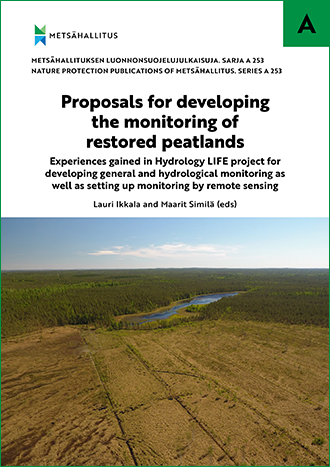Proposals for developing the monitoring of restored peatlands – Experiences gained in Hydrology LIFE project for developing general and hydrological monitoring as well as setting up monitoring by remote sensing
Peatland restoration is an effective means to slow down biodiversity loss as well as to promote flow regulation, water purification and carbon sequestration. Restoration activities are increasing significantly, and thus, more applicable, fluent and efficient monitoring methods are needed to show the restoration impacts and to respond to the development needs of the methods.
On the Finnish state-owned land, peatland restoration monitoring can be divided into technical general monitoring and impact monitoring which uses a monitoring network to study the longterm changes in peatland hydrology and vegetation. Besides the conventional monitoring methods, remote sensing has a strong potential to widen the observations from single points or limited areas to the whole peatland site.
This report gathers the proposals and development recommendations from the Hydrology LIFE project. During the project, peatland restoration monitoring was developed by gathering the experiences on general monitoring and hydrological fieldwork from the restoration planners and site managers using a poll survey and workshops. Furthermore, the 10-year hydrological data from over 40 sites in the monitoring network was processed and peat and pore water samples were gathered and analysed during the project. Also, remote sensing methods were introduced using a literature review and picked methods were tested and developed at the project sites. Highresolution drone data from over 20 sites were also gathered and analysed.
Updated guidelines and regular training were emphasized in the monitoring development needs. The survey respondents wanted to keep general monitoring flexible also in the future, but observing still needs uniforming. The 10-year observation data shows that the restored water levels might be more sensitive to interannual variability than the water levels at corresponding pristine sites. Restoration produces a temporary interference in the water quality, but it diminishes during 5–10 years after the restoration. The unique data from the monitoring network should be opened for free use by all researchers.
Remote sensing was considered an appropriate tool for supplementing the ground-level observations on peatland surface moisture, vegetation, greenhouse gas emissions and peat properties, on open peatlands in particular. To enable quantitative observations, however, usually also ground truth observations are needed. Drones are a rather easy way to produce highresolution datasets, but their more systematic use requires resources for technical development and quality control.
The results of the report can be used in the development work of the monitoring guidelines and the environmental authority’s geoinformation system. Remote sensing experiences and the literature review support increasing technical monitoring of peatlands. Experiences can be applied in organizing peatland restoration monitoring also outside the state-owned protection areas.

